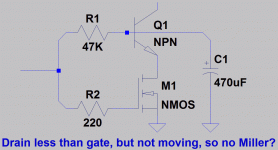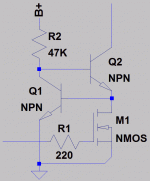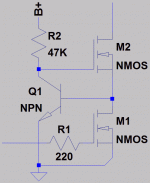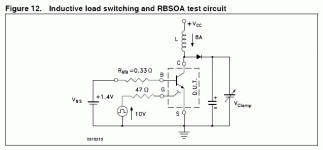Can such a simple trick nail MOSFET gate capacitance to a constant?
I have never seen an ESBT self-biased in this way before, is it new?
Can we now use MOSFET without squirming cap at stOOpid low VDS?
------
And a trio provides base current...
I have never seen an ESBT self-biased in this way before, is it new?
Can we now use MOSFET without squirming cap at stOOpid low VDS?
------
And a trio provides base current...
Attachments
Last edited:
Ken,
It's clever, but precisely what problem does it solve?
Hugh
Unpredictable Miller capacitance at Low VDS.
Imagine the gate capacitance as-if an air bubble were squishing
back and forth from source to drain under a piece of Scotch Tape.
Situation I wish to avoid... Nothing against the Scotch.
Last edited:
Working an FET with Drain below turn-on voltage puts you into a very different mode of operation, with soft "plate resistance" and lower and more-variable Gm.
In a sense, instead of squishy C skewing your highs you have squishy resistance parameters skewing everything.
Your Trio looks to me like a 3-stage amplifier which is liable to self-oscillate.
Have you tried these on breadboard?
In a sense, instead of squishy C skewing your highs you have squishy resistance parameters skewing everything.
Your Trio looks to me like a 3-stage amplifier which is liable to self-oscillate.
Have you tried these on breadboard?
I think base current will be a bitch with your first two self-bias circuits. The third one (with 2 MOSFETs) looks interesting, if you can get it stable.Can such a simple trick nail MOSFET gate capacitance to a constant?
I have never seen an ESBT self-biased in this way before, is it new?
Wouldn't it be easier just to use an ESBT as intended? You get almost constant voltage across the MOSFET. Judging from the pic below (swiped from a datasheet), it seems normal to run these things with very low Vds.
BTW, Nelson Pass mentioned awhile ago that he'd been playing with ESBTs. I wonder if anything interesting will come of that?
Attachments
Working an FET with Drain below turn-on voltage puts you into a very different mode of operation, with soft "plate resistance" and lower and more-variable Gm.
In a sense, instead of squishy C skewing your highs you have squishy resistance parameters skewing everything.
Your Trio looks to me like a 3-stage amplifier which is liable to self-oscillate.
Have you tried these on breadboard?
I'm not sure how the dynamic resistance of a cascode or ring of
two could be squishy? Gm might be reduced or curved or both...
Some curves are useful. If it turned out to be square law, that
might be a very good thing. Other curves, maybe not so useful.
But my magic eight ball don't tell me whats gonna happen.
Time to consult the entrails on a breadboard, or whatever...
Last edited:
Member
Joined 2009
Paid Member
Looks interesting,
http://www.st.com/internet/com/TECH...FERENCE_PAPER/BUonomo_Scollo_UnivCta_2008.pdf
Look at the linearity in fig6
http://www.st.com/internet/com/TECH...FERENCE_PAPER/BUonomo_Scollo_UnivCta_2008.pdf
Look at the linearity in fig6
- Status
- This old topic is closed. If you want to reopen this topic, contact a moderator using the "Report Post" button.
- Home
- Amplifiers
- Solid State
- New super pair?



